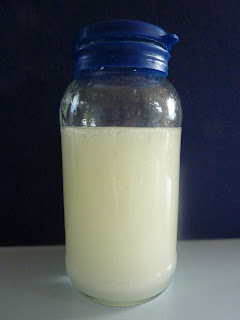 Ever made your own salad dressing? For a vinaigrette, ever wondered why the result is opaque even though most of the ingredients are clear? Vinegar is typically clear, as is oil – a trick of optics makes the results opaque, which is easily demonstrated at home (In case you want to check this one out for yourself).
Ever made your own salad dressing? For a vinaigrette, ever wondered why the result is opaque even though most of the ingredients are clear? Vinegar is typically clear, as is oil – a trick of optics makes the results opaque, which is easily demonstrated at home (In case you want to check this one out for yourself).Put oil and water (as a stand in for the vinegar) together in a jar (see picture). Oil floats on water with an easily seen interface. The background of my blue cutting board shows through for both layers. Vigorous shaking of the jar creates a emulsion of the two liquids. An emulsion is not the same as mixing, since the oil and water don't actually mix. Instead, both liquids form tiny bubbles that co-exist beside each other – over time they would separate back out into two layers. Once the emulsion forms it become opaque (see picture number 2).
An opaque liquid like mud (tiny dirt particles suspended in water) operates differently – mud's opaque because it absorbs much of the light incident upon it. Our oil and water looks opaque because of back reflection. Each tiny drop of oil and water remains clear. Now gizillions of surfaces form, separating the oil and water and each interface reflects light. Since the drops are round, the light isn't reflected perfectly back where it came from like a mirror, instead it scatters in all directions. This scattering creates a matte look to the emulsion – like the look of white paper.
 As a tangent, under high magnification, white paper consists of random criss-crossing fibers that also scatters the light incident upon it. So a vinaigrette and white paper have something in common.
As a tangent, under high magnification, white paper consists of random criss-crossing fibers that also scatters the light incident upon it. So a vinaigrette and white paper have something in common.If you sit your vinaigrette on the counter for a few moments, the two layers will reform quite quickly. To keep an emulsion emulsified for a longer period of time, an emulsifier can be added. Mustard or honey are often added to vinaigrettes for this reason and their tastiness. Egg yokes can also be used and they typically act as an emulsifier for mayonnaise.
No comments:
Post a Comment